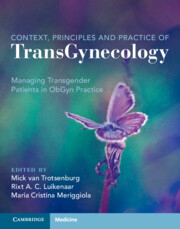Book contents
- Context, Principles, and Practice of Transgynecology
- Context, Principles, and Practice of Transgynecology
- Copyright page
- Dedication
- Contents
- Foreword
- Preface
- Contributors
- Abbreviations
- Section A Contextual Transgynecology
- Section B Practicing Transgynecology
- Chapter 9 Gynecological Office Medicine for Trans and Gender Diverse People
- Chapter 10 Features of Imaging in Transgender Persons
- Chapter 11 Benign Gynecological Conditions in Transgender and Gender Diverse People
- Chapter 12 Urogynecological Disorders
- Chapter 13 Painful and Frequent Micturition
- Chapter 14 Diagnostics and Treatment of Gynecological and Nongynecological Causes of Pelvic Pain
- Chapter 15 Gynecological Attention to the Prostate
- Chapter 16 Vaginal Dilators and Dilating after Vaginoplasty
- Chapter 17 Transenology
- Section C Gynecological Surgery for Transgender Males
- Section D Sexuality and Contraception
- Section E Fertility and Reproduction
- Section F Impact of Gender-affirming Hormonal Therapy on Genital Organs
- Section G Screening and Prophylaxis
- Transgynecology Index
- References
Chapter 15 - Gynecological Attention to the Prostate
from Section B - Practicing Transgynecology
Published online by Cambridge University Press: 22 December 2022
- Context, Principles, and Practice of Transgynecology
- Context, Principles, and Practice of Transgynecology
- Copyright page
- Dedication
- Contents
- Foreword
- Preface
- Contributors
- Abbreviations
- Section A Contextual Transgynecology
- Section B Practicing Transgynecology
- Chapter 9 Gynecological Office Medicine for Trans and Gender Diverse People
- Chapter 10 Features of Imaging in Transgender Persons
- Chapter 11 Benign Gynecological Conditions in Transgender and Gender Diverse People
- Chapter 12 Urogynecological Disorders
- Chapter 13 Painful and Frequent Micturition
- Chapter 14 Diagnostics and Treatment of Gynecological and Nongynecological Causes of Pelvic Pain
- Chapter 15 Gynecological Attention to the Prostate
- Chapter 16 Vaginal Dilators and Dilating after Vaginoplasty
- Chapter 17 Transenology
- Section C Gynecological Surgery for Transgender Males
- Section D Sexuality and Contraception
- Section E Fertility and Reproduction
- Section F Impact of Gender-affirming Hormonal Therapy on Genital Organs
- Section G Screening and Prophylaxis
- Transgynecology Index
- References
Summary
The prostate is an accessory gland and together with the seminal vesicles, bulbourethral and urethral glands, the testis and epididymis, produces seminal fluid or semen. It is the size of a walnut and is situated below the bladder and in front of the rectum and produces prostate-specific antigen (PSA). The development and function of the prostate are hormone dependent. Pathological changes occur as men age and these can lead to medical interventions. In general, the only indication to remove the prostate is in case of localized prostate cancer. In transgender women therefore the prostate remains in situ unless there is prostate cancer. Cross-sex hormonal (CSH) therapy lower androgen levels and by this BPH and prostate cancer rarely occur in transgender women on CSH. This chapter discusses the prostate in trans female persons and basic care principles.
Information
- Type
- Chapter
- Information
- Context, Principles and Practice of TransGynecologyManaging Transgender Patients in ObGyn Practice, pp. 114 - 118Publisher: Cambridge University PressPrint publication year: 2022
References
Accessibility standard: Unknown
Why this information is here
This section outlines the accessibility features of this content - including support for screen readers, full keyboard navigation and high-contrast display options. This may not be relevant for you.Accessibility Information
- 1
- Cited by
